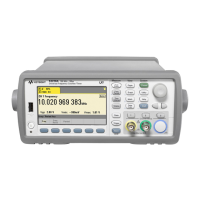7Formats and Data Flow
252 Keysight 53220A/53230A User’s Guide
2 all readings are stored in an internal counter format - the programmed format
(FORMat subsystem) is set when readings are transferred to the output buffer.
3 if reading memory overflows the first (oldest) readings are overwritten and the
‘Reading Mem Ovfl’ bit (14) in the Questionable Data Register is set. The most
recent measurements are retained.
Output buffer
Data is available to the PC over the LAN, USB, and GPIB interfaces once it is in the
output buffer (Figure 7-1). The following section explains how readings are
transferred from memory to the buffer. If during a transfer the output buffer fills,
command execution is paused until readings are removed by the PC - creating
room in the buffer. No readings are lost.
Transferring readings from memory to the output buffer
The following commands transfer readings from volatile reading memory to the
buffer.
READ? - is equivalent to executing INITiate:IMMediate directly followed by
FETCh?. With READ?, once all readings specified by TRIGger:COUNt and
SAMPle:COUNt are complete and in memory, they are instantaneously read into
the output buffer (Figure 7-1).
If the data format is REAL (FORMat subsystem), each block of readings generated
by READ? is preceded by an IEEE 488.2 Indefinite-Length block header
(Table 7-1). As such, when sending multiple commands in a single command
string, READ? should always be the last command in the string.
READ? example
// frequency meas of 500 kHz signal with uHz resolution
CONF:FREQ 500E3, 1E-6, (@1) // configure counter
TRIG:COUN 1 // set trigger count
SAMP:COUN 10 // take 10 readings
READ? // read readings when complete

